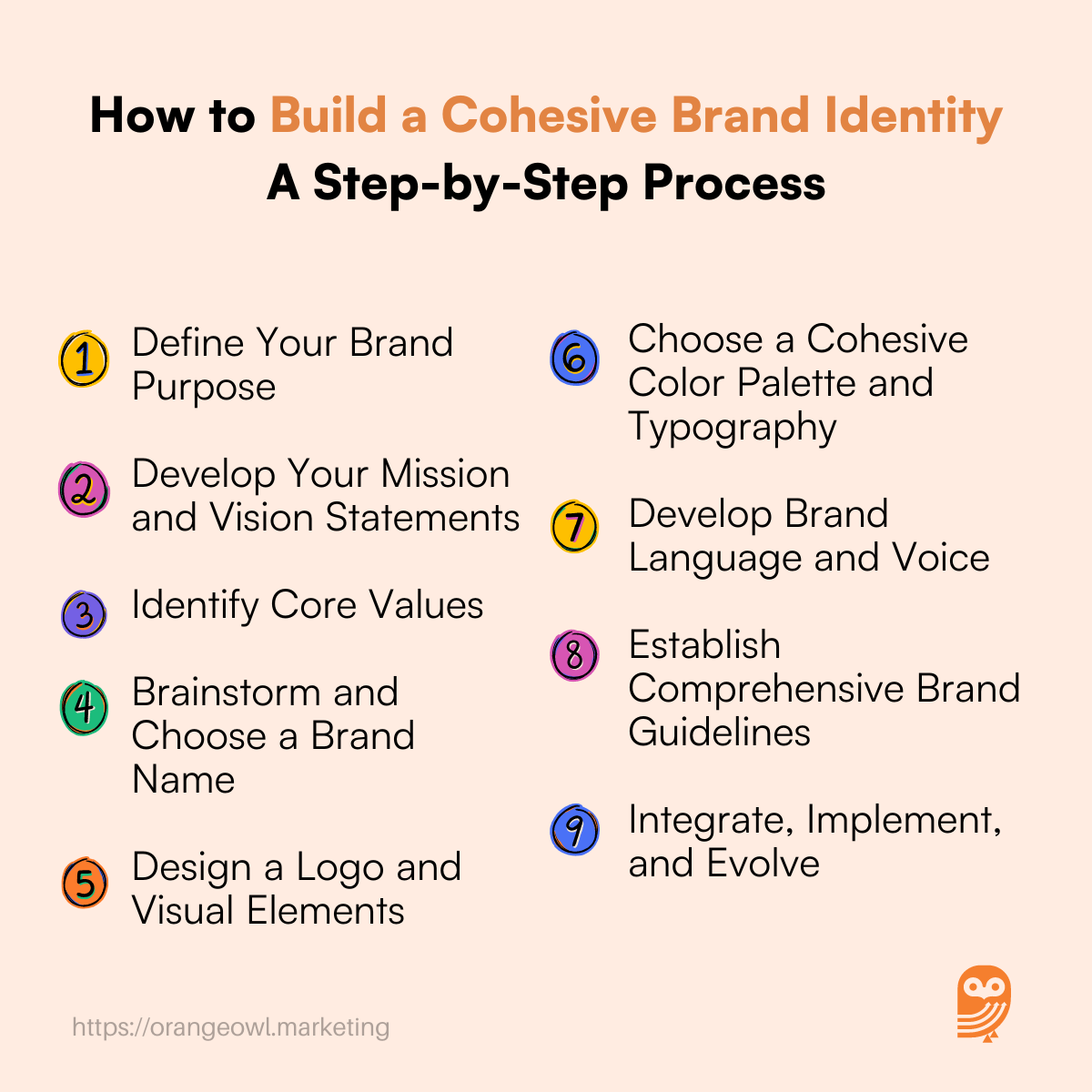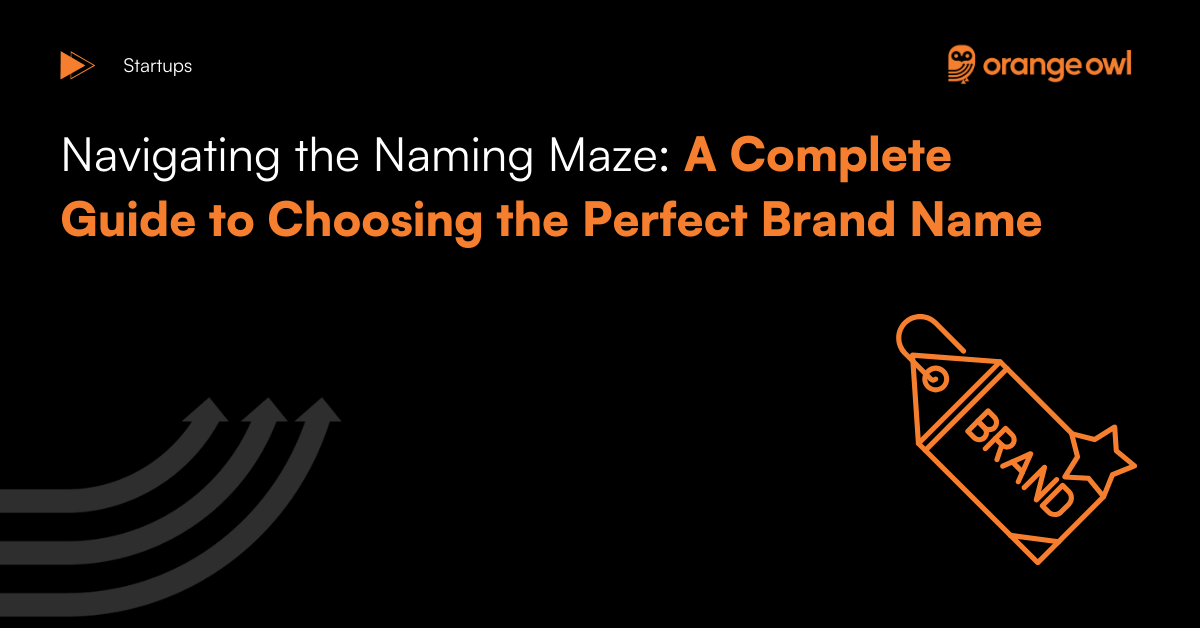Crafting a Cohesive Brand Identity for Startups: A Holistic Approach
Vivek Goel
February 9, 2025

Table of Contents
In today’s hyper-competitive market, a startup’s brand identity is far more than just a name or a logo—it’s the very essence of the business. A well-crafted brand identity serves as a promise to your customers and a guiding star for your internal team.
Establishing brand identity for startups involves more than just selecting a catchy name or designing an appealing logo; it requires a thoughtful alignment of your brand name, logo, mission, vision, values, language, and voice. Together, these elements form a unified brand story that resonates with your audience and drives long-term success.
This article examines how startups can seamlessly integrate these elements to establish a compelling brand identity that not only differentiates them in the market but also cultivates enduring relationships with customers and stakeholders. In fact, 78% of consumers—and 88% of Gen Z—believe a brand’s social media presence now plays a greater role in earning their trust than it did a year ago.
The Foundation of Brand Identity for Startups: Start with a Purpose
Before diving into the specifics of naming your startup or designing a logo, it’s crucial to anchor your brand identity in a clear and compelling purpose. Your brand’s purpose is the “why” behind your business—why it exists, whom it serves, and what impact it aims to make.
Aligning Purpose with Mission and Vision
- Mission Statement: Your mission statement should articulate your company’s purpose in the present—what you do, whom you serve, and how you deliver value. For example, a mission to “empower small businesses with innovative technology solutions” clearly defines the company’s role and commitment to its audience.
- Vision Statement: The vision statement, on the other hand, should describe your company’s long-term aspirations—what you aim to achieve in the future. A vision like “to be the global leader in sustainable tech innovations” gives direction and ambition, setting the stage for future growth.
Expert Insight: Startups that take the time to deeply understand and articulate their purpose are better positioned to make strategic decisions that align with their long-term goals. This clarity also ensures that every aspect of the brand—from the name to the visual identity—resonates with the intended audience.
Crafting a Memorable Brand Name
The process of naming your startup is a critical step in shaping your brand identity. A well-chosen name not only communicates your brand’s essence but also sets the tone for your company’s narrative.
Key Considerations:
- Clarity and Simplicity: A clear and simple name ensures that your brand is easily recognizable and memorable. It should convey your company’s essence without unnecessary complexity.
- Relevance and Uniqueness: The name should be relevant to your industry and audience while also being unique enough to differentiate you from competitors.
Example: Consider the name “Slack.” It’s short, easy to remember, and conveys a sense of simplicity and ease, which aligns with the company’s mission to make team communication seamless.
Connecting to Purpose: The brand name should reflect the core of what your company stands for. If your mission is to make sustainable living accessible, your name should evoke ideas of eco-friendliness and innovation.
Expert Tip: Conduct thorough market research to ensure your name is not only unique but also culturally appropriate across different markets, especially if you plan to expand internationally.
Designing a Logo That Speaks Volumes
Your logo is often the first visual touchpoint between your brand and potential customers. It should be a visual representation of your brand’s mission, vision, and values—communicating your brand story at a glance.
Considerations for Effective Logo Design:
- Versatility: Your logo should be versatile enough to work across various platforms and mediums, from business cards to billboards. It should also be adaptable to different color schemes, including black-and-white versions.
- Simplicity: A simple logo is more memorable and easier to recognize. It should capture the essence of your brand without being overly complex.
Example: The Nike Swoosh is a prime example of a simple yet powerful logo. It conveys motion and speed, aligning with Nike’s mission to bring inspiration and innovation to athletes.
Connecting to Mission and Vision: Your logo should visually encapsulate the essence of your mission and vision. If your vision is to lead in sustainable technology, consider design elements that evoke nature, innovation, and forward-thinking.
Expert Tip: When finalizing your logo, ensure you have all necessary file formats (AI, PNG, SVG) and variations (full-color, monochrome) to maintain brand consistency across different platforms.
Defining and Living Your Company Values
Company values are the guiding principles that shape your organizational culture and influence every decision. They are the DNA of your brand identity, reflecting what you stand for and how you conduct business.
Integrating Values into Brand Identity:
- Authenticity: Your values should be authentic and reflective of your company’s true beliefs. They should guide everything from daily operations to long-term strategies.
- Alignment: Ensure your values are aligned with your mission and vision. This alignment creates a cohesive brand story that is consistent across all touchpoints.
Example: Patagonia’s values, which emphasize environmental stewardship and ethical business practices, are evident in everything the company does—from product development to marketing campaigns.
Expert Insight: Regularly communicate and reinforce your values within your organization. This not only strengthens your brand identity but also ensures that your employees are aligned with the company’s mission and vision.
Building Brand Language and Voice
While the brand name, logo, mission, vision, and values form the core of your brand identity, expanding the discussion to include brand language and brand voice is essential. These elements ensure that your brand communicates consistently and effectively across all platforms and touchpoints.
Brand Language:
- Definition: Brand language refers to the specific choice of words, phrases, and tone used in all forms of communication—whether it’s marketing copy, customer service interactions, or internal communications.
- Importance: The language you use shapes how your brand is perceived by your audience. Consistent and carefully chosen brand language can reinforce your brand’s identity and values, making your messaging more recognizable and impactful.
Example: Apple’s brand language is simple, clear, and focused on the user. Whether it’s product descriptions, advertisements, or customer support, the language is consistent, reflecting the brand’s values of simplicity and user-centricity.
Brand Voice:
- Definition: Brand voice is the distinct personality that your brand takes on in all of its communications. It’s how your brand “sounds” to your audience and is a key component of your overall brand identity.
- Importance: A consistent brand voice builds trust and familiarity with your audience. It helps to create a cohesive brand experience, making your brand more relatable and memorable.
Example: Mailchimp has a playful, friendly brand voice that makes complex email marketing tasks feel approachable and fun. This voice is consistent across all their communications, from their website to their customer support interactions.
Expert Tip: Develop a brand language and voice guide that outlines preferred terms, tone, and style for different communication channels. This guide ensures that everyone in the organization communicates in a way that aligns with the brand’s identity.
Developing Comprehensive Brand Guidelines
Creating a cohesive and recognizable brand identity goes beyond just the visual elements; it requires a detailed set of brand guidelines that ensure consistency across all touchpoints. Comprehensive brand guidelines serve as the rulebook for how your brand is presented to the world, covering everything from logo usage to tone of voice. Here’s how to develop these guidelines effectively:
What Are Brand Guidelines?
Brand guidelines are a set of standards that dictate how your brand’s visual and verbal elements should be applied across different mediums. They ensure that your brand remains consistent, recognizable, and true to its core values, regardless of who is representing it.
Key Components of Brand Guidelines:
Logo Usage
- Guidelines: Define how and where the logo should be used, including size, spacing, and placement. Include acceptable variations, such as black and white versions or alternative orientations.
- Dos and Don’ts: Provide examples of correct and incorrect logo usage to prevent distortion, color changes, or other misrepresentations.
Color Palette
- Primary Colors: Outline the main colors associated with your brand, including their specific color codes (e.g., HEX, RGB, CMYK).
- Secondary Colors: Include any additional colors that complement the primary palette, often used for backgrounds, accents, or other design elements.
- Usage Guidelines: Explain when and how each color should be used to maintain brand consistency.
Typography
- Primary Typeface: Specify the fonts to be used in all brand communications, including headers, body text, and call-to-actions.
- Alternative Fonts: Provide alternative font options for digital versus print materials or when the primary typeface isn’t available.
- Usage Instructions: Include guidelines on font sizes, weights, and line spacing to ensure consistency.
Imagery and Graphics
- Style Guide: Describe the style of imagery that aligns with your brand (e.g., minimalistic, vibrant, realistic). Include examples of appropriate and inappropriate imagery.
- Graphic Elements: Define any specific icons, patterns, or illustrations that are part of your brand identity and explain their correct usage.
Brand Language and Voice
- Tone and Style: Clearly define the tone (e.g., formal, casual, playful) and style (e.g., concise, detailed) that should be used across all communications.
- Key Phrases and Messaging: List preferred terms and phrases that align with your brand values and mission. Include messaging examples that demonstrate how to communicate effectively within the brand voice.
- Adaptations: Explain how the tone might vary across different platforms (e.g., social media vs. corporate communications) while maintaining a consistent brand voice.
Applications and Examples
- Digital Media: Provide guidelines for how the brand should appear on websites, social media platforms, email templates, and other digital assets.
- Print Media: Include rules for printed materials such as business cards, brochures, and packaging, ensuring the brand is represented consistently in physical formats.
- Merchandising: Offer guidance on how to apply the brand to merchandise, including apparel, promotional items, and other branded products.
Legal Considerations
- Trademark Usage: Clarify how to use trademarked elements like the logo or brand name. Include legal disclaimers if necessary.
- Brand Protection: Offer instructions on how to monitor and protect the brand from misuse, including procedures for addressing violations.
Brand Implementation
- Internal Communication: Provide guidance on how to educate and train team members about the brand guidelines to ensure consistency.
- External Communication: Explain how to communicate brand guidelines to external partners, such as agencies or freelancers, to maintain brand integrity.
Monitoring and Updates
- Review Schedule: Establish a regular review process to keep brand guidelines up-to-date with any changes in the brand strategy, market trends, or company growth.
- Feedback Loop: Encourage feedback from users of the brand guidelines to identify any areas that need clarification or adjustment.
Expert Tip:
Developing comprehensive brand guidelines is an investment in the long-term consistency and success of your brand. Engage designers, marketers, and other stakeholders in the creation of these guidelines to ensure they are practical, clear, and aligned with your overall brand strategy.
By establishing clear brand guidelines, you ensure that your brand identity remains consistent, cohesive, and recognizable across all platforms and communications, helping to build trust and loyalty with your audience.
How to Build a Cohesive Brand Identity: A Step-by-Step Process
Creating a cohesive brand identity requires a strategic approach. Here’s a step-by-step process to help you navigate through the different components:
1. Define Your Brand Purpose:
Start by clearly articulating the purpose of your brand. This is the foundation upon which your entire brand identity will be built. Ask yourself why your company exists, whom it serves, and what impact it aims to have.
2. Develop Your Mission and Vision Statements:
With your purpose in mind, craft your mission and vision statements. The mission should focus on your company’s current role and operations, while the vision should describe your long-term aspirations.
3. Identify Core Values:
Identify the core values that will guide your company’s actions and decision-making processes. Ensure these values align with your mission and vision and reflect what you truly stand for as a company.
4. Brainstorm and Choose a Brand Name:
Based on your mission, vision, and values, brainstorm potential brand names. Choose a name that is clear, simple, relevant, and unique. It should encapsulate your brand’s essence and be easy for your audience to remember and pronounce.
5. Design a Logo and Visual Elements
Once your brand name is finalized, work on designing a logo that visually represents your brand’s identity. The logo should be versatile, simple, and aligned with your brand’s mission and vision. Additionally, choose a cohesive color palette and typography that reflect your brand’s personality and values.

6. Develop Brand Language and Voice
Create a brand language guide that outlines the tone, style, and specific words or phrases that should be used in all communications. Define your brand’s voice to ensure consistency across all platforms, whether it’s formal, friendly, authoritative, or playful.
7. Establish Comprehensive Brand Guidelines
Develop brand guidelines that include all visual and verbal elements, such as logo usage, color schemes, typography, imagery styles, and tone of voice. These guidelines will serve as a reference to ensure consistency across all brand touchpoints, from marketing materials to internal communications.
8. Integrate and Implement
With all elements in place, integrate them into every aspect of your business. Ensure that your brand name, logo, mission, vision, values, language, and voice are consistently applied across all touchpoints, including your website, social media, customer service, and internal communications.
9. Monitor and Evolve
Regularly review your brand identity to ensure it remains aligned with your company’s goals and market trends. Be open to evolving your brand identity as your business grows and market conditions change.
Expert Tip: Engage your team and key stakeholders throughout this process to ensure buy-in and alignment. This collaborative approach helps create a strong, unified brand identity that resonates both internally and externally.
The Power of a Cohesive Brand Identity
A strong brand identity is not created overnight. It requires thoughtful integration of your brand name, logo, mission, vision, values, language, and voice—each element reinforcing the other to tell a cohesive and compelling brand story.
Final Thoughts:
- Consistency is Key: Ensure that every element of your brand identity is consistent with your purpose, mission, and vision. This consistency builds trust and recognition among your audience.
- Evolve with Intention: As your startup grows, revisit and refine your brand identity elements to ensure they continue to align with your evolving mission and vision.
Conclusion – Brand Identity for Startups
By taking a holistic approach to crafting your brand identity, you not only differentiate your startup in a crowded market but also create a strong foundation for long-term success. Your brand name, logo, mission, vision, values, language, and voice are not just isolated elements—they are interconnected components of a larger narrative that defines who you are, what you stand for, and where you’re headed.
Frequently Asked Questions (FAQs) on Cohesive Brand Identity for Startups
A cohesive brand identity helps a startup establish a strong market presence, build trust with customers, and create a consistent experience across all touchpoints.
Brand identity is how you define and present your brand through elements like name, logo, and messaging, while brand image is how the public perceives your brand.
Brand language shapes how your brand communicates and is perceived. It ensures that all messaging is consistent with your brand’s values and voice.
Yes, as your company grows and market conditions change, your brand identity may need to evolve to stay relevant and aligned with your business goals.
Develop a brand voice guide that outlines the tone and style for all communications, and ensure that all team members adhere to these guidelines.
Without a defined brand identity, your brand may appear inconsistent, confusing customers and weakening your market position.
Company values shape the culture and behavior of the organization, influencing everything from customer interactions to marketing strategies, thereby defining your brand identity.
It’s a good practice to review your brand identity annually or during significant company milestones to ensure it remains aligned with your business objectives.
Brand language refers to the specific words and phrases used in communications, while brand voice is the overall personality and tone that your brand conveys.
You can measure the effectiveness of your brand identity through customer feedback, brand recognition studies, and consistency in how your brand is represented across different platforms.


